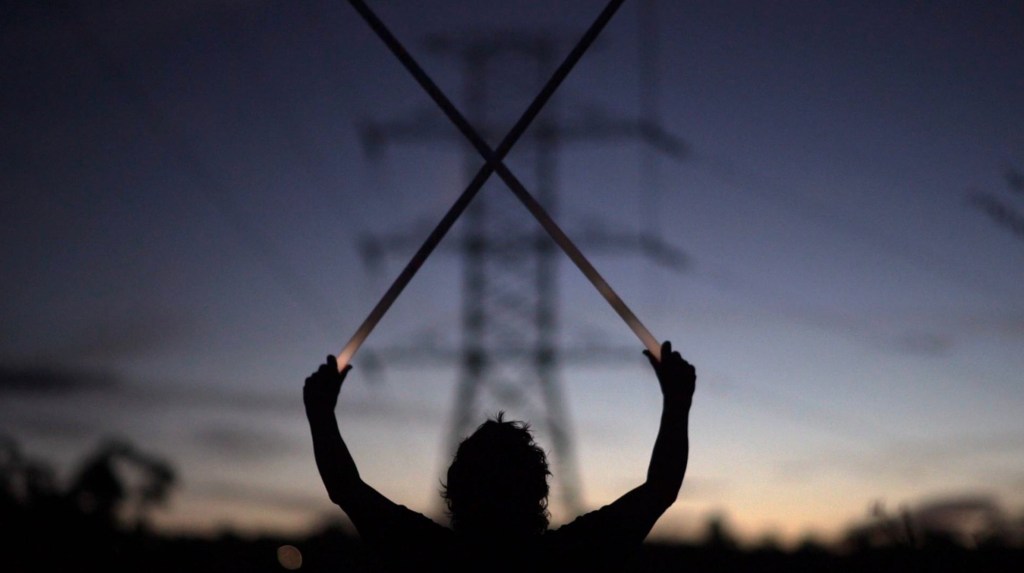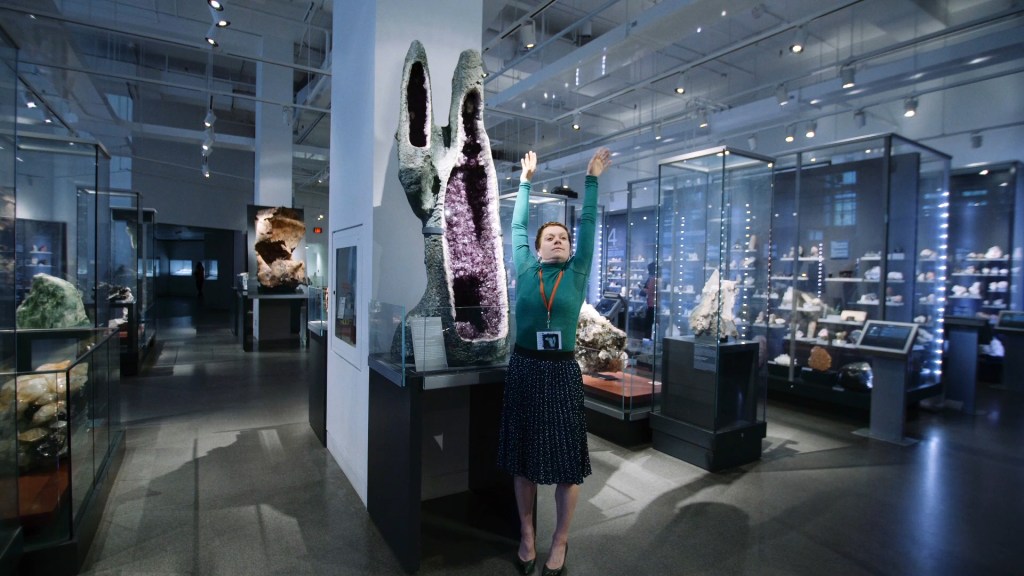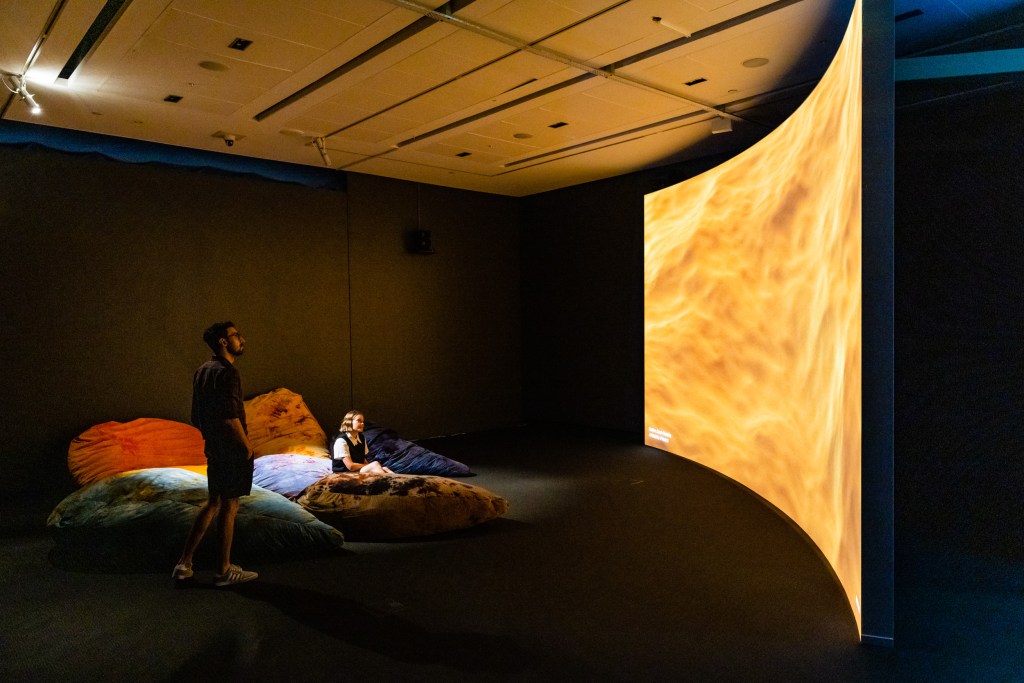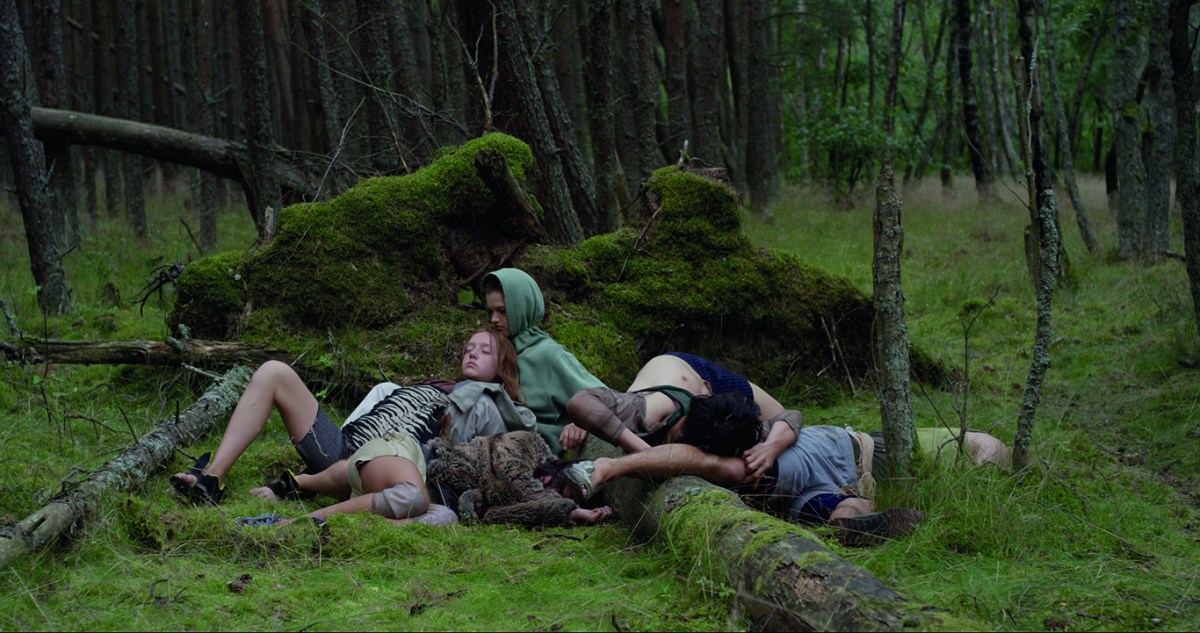Simply, We Are Electric is an exhibition about energy. But it is so much more than that. It maps our interaction with resources, our environmental footprint, the politics of extraction and its connection to human evolution and industrial expansion (both hope-driven and doom-tainted) as we move towards a post-carbon future.
Curated by Anna Briers, it is an ambitious exhibition that is both eloquent and erudite in its pairings and narratives. Starting in the upstairs galleries of UQ Art Museum, visitors first encounter the celebrated video work by [David] Haines and [Joyce] Hinterding, Encounter with the Halo Field (2009-2015) alongside George Tjungurrayi’s painting Tingari (2004).
In the video, the artists perform a kind of choreographic dance with a pair of fluroescent tubes that pick up on the energy field emanating from transmission towers and powerlines. In a similar way, Tjungurrayi’s painting makes visible the energy fields of Country, its optical shimmer capturing something ordinarily not seen when looking across a landscape.

That unspoken visualisation is a recurrent theme across the exhibition, encouraging viewers to start to think beyond their knowledge of energy to a more bodily or sensorial consideration of the silent impact we have on the environment.
It continues in the next gallery with a single-channel video by Canadian artist Diane Borsato, Gems and Minerals (2018), which has been filmed within the Royal Ontario Museum’s collection of geological specimens and crystals. Here, the artist worked with nonverbal invigilators who recount personal narratives in American Sign Language, again picking up on this kind of slippage between the physical, the emotional and the esoteric as material witness.

Taking on the responsibility of ‘witness’ is an interesting position we have to navigate in our own way, as we decide our own levels of engagement with the environmental crisis. No work better presents this contemporary dilemma than Elise Rasmussen’s film, In the Valley of the Moon (2022), which sutures images of Elon Musk’s Tesla Gigafactory – the largest producer of electric vehicles – with scenes of the Atacama salt mines in Chile and the extraction of lithium from Indigenous lands. It problematises and complicates green energy futures.
Moving down to the lower level galleries, that vibration or energy field takes on a musicality with Megan Cope’s installation Untitled (Death Song), 2020. This piece also picks up on the threat of extinction – both as superseded technologies and wildlife (in this case birdlife) as an outcome of those technologies. Cope’s work is a call to reconsider Indigenous land management systems, as opposed to settler colonial land management systems. It has a nice connection with the activist paintings by First Nations artist Jack Green.
Cope’s installation looks superb in the space, its rusty mining augers and scaffolding from oil rigs playing off a historic organ that lives in the gallery – both pregnant with their sonic potential.
Although not in sight of, Cope’s work has a loose connection with Cameron Robbins’ kinetic sculpture, Helio Ephemera (2022), which harnesses renewable energy via a solar panel outside to drive a marble wheel that is marked by a graphite pencil. Robbins beckons us to be attentive to nature’s rhythms and cycles.

This connects beautifully with a newly commissioned installation by Michaela Gleave, titled Terrella (2022). She’s using data collected via live stream from geomagnetic listening stations dotted around the globe. By mapping the Earth’s electromagnetic field, Gleave asks what does the earth’s energy sound like? And what is our place in this interconnected world energy?
It is a similar consideration that Eglé Budvytytè considers in their film, Songs from the compost: mutating bodies, imploding stars, a sure highlight of this exhibition. In it, a connected group of non-binary performers move through an incredible landscape, at times stopping to rest. Therein, we are witness to their entanglement as they gradually mutate with the earth. Briers explains, ‘You can see these subtle kinds of cyborg extensions or funky growths, like their bodies are portals or ways of becoming. It is a work that is very much about interdependence and vulnerability and care.’
Read: Exhibition review: Ying Ang, CCP
She says it proposes an alternative to Darwin’s idea of the survival of the fittest, and rather plays off the idea that we are not singular entities, but collect bacteria in our journey, collaborating with plants in a symbiotic way that is ‘a sort of remedy for the Anthropocene’.
Briers concludes of the exhibition, ‘I was very much thinking about the way that our bodies are energetic, and how energy slips between ourselves and the earth, surrounded by an electromagnetic circuit.’ She continues, ‘The whole show really is a kind of call to think beyond Petro-Capitalism, and our whole economic structure, which is contingent on the extraction. So how can we think beyond that?’
We Are Electric: Extraction, Extinction and Post-Carbon Futures
UQ Art Museum, Brisbane
14 February – 24 June 2023
Free
Curator: Anna Briers
Artists: Will Benedict, Diane Borsato, Eglé Budvytytè, Megan Cope, Michaela Gleave, Jack Green, Haines and Hinterding, The Institute of Queer Ecology, Mavis Ngallametta, Dane Mitchell, Elise Rasmussen, Cameron Robbins, Yasmin Smith, George Tjungurrayi, Girringun Art Centre: Daniel Beeron (Galaman), Davina Harries, Judith Henry, Clarence Kinjun, Doris Kinjun, Debra Murray and Eileen Tep.





